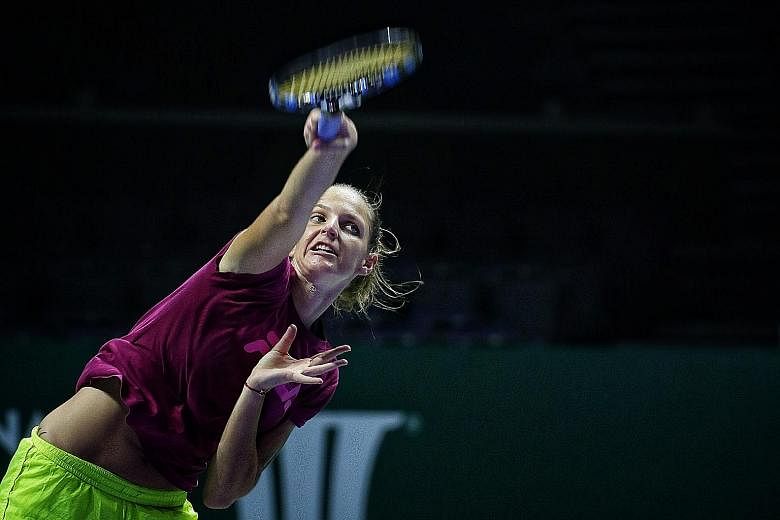In sport so much happens so fast because athletes work in units of time we don't quite comprehend. Divers launch art movements in less than two seconds from a 10m platform. Lionel Messi pauses an extra millisecond till a defender starts to commit and then accelerates away. Basketballers hold the ball with calculated calm and then shoot as the last second starts to die on a digital clock.
It is this rarefied, abridged, condensed world that I'm briefly given entry to on Friday. Where my success depends on what I decide and how I move in the next .60 of a second. By roughly which time Karolina Pliskova's flat, hard serve is going to arrive in my vicinity. Preferably not directed at my body.
It's that Pliskova. The taller Czech twin, the right-handed sister, with the lithe build of a hungry high jumper. She's a good sport and an even better server: 517 aces in 2015, 530 in 2016, 2,185 in her career and 10 or more aces in a match 13 times this year. This year she's hit a mere 438 aces. The three she has against me will apparently not be counted.
The tennis serve is the introduction to action or sometimes just a full stop. It is the stroke with the longest preface and the most personality because every player approaches it differently. Some sniff tennis balls before serving while others examine them with a concentration usually reserved for engagement rings. Maria Sharapova arranges her hair, Rafael Nadal adjusts his shorts, and Pat Rafter politely said "sorry, mate" after every faulty ball toss. Routine is everything.
Big Bill Tilden could hold five balls with one hand while Pete Sampras took a single ball at a time. Usually he did not need more. Serena Williams hits her serve with a beautiful matter-of-factness, Martina Navratilova had a degree in slice and Novak Djokovic used to bounce the ball so often it seemed he was caught in an existentialist dilemma over whether to serve at all.
On Friday a serene Pliskova bounced the ball only once. I asked if I could face 10 serves and got 14. Two were faults. All were quick. One I snicked. Another seemed to hit the backboard before I had even turned. Later I discovered that statistically she prefers to serve down the line on the ad court but even fresh data can't help slow feet.
I came armed with plans. But of course. I stood a metre behind the baseline and asked the charming Pliskova to serve only from the ad court to my backhand which is my least worst - we don't dare use "best" in such company - shot.
I summoned my inner Halep (the best returner, said Pliskova) and recalled John McEnroe's advice at Wimbledon in 1992 to Andre Agassi which was to shorten his strokes. And, finally, I imagined myself as a reincarnation of Lucky Luke, a cowboy comic character who could shoot "faster than his own shadow".
Nothing worked.
I could have brazenly walked into the court, almost to the service line, as Michael Chang did at the 1989 French Open which resulted in a double fault from Ivan Lendl at match point. But that would be rude. And, considering she was serving in the region of 165kmh, unwise from a safety point of view.
Pliskova later said she was serving at "80 to 90 per cent" and insisted she's not one of the biggest servers on tour. This did not appease me considering that one of her serves hit the net cord, slowed down and still aced me. But her point was that it's not speed she searches for but spots on the court: a sort of unbeatable union of pace and precision.
Pliskova's serve is a piece of languid architecture, oiled and unexaggerated, or as the former player Rennae Stubbs, who is coaching her this week, said: "It's one of the most technically sound service motions ever in the women's game". Not to mention harder to read than some of the classics that teachers force-fed me.

Sampras' early coach used to pause till he had finished his service toss before instructing him where to hit it. The American had disguise, so does Pliskova. Not that it matters to amateurs like me who survive only on uneducated guesses. We don't have data, haven't developed intuition, can't tell by the direction a tongue is pointing - which is reportedly how Agassi worked out Boris Becker's serve - and at best lunge like guessing goalkeepers.
So, did I return some of her serves? Yes. Should I boast about them? Depends on your definition of return. Did my stinging, flat, Connors-esque replies hurtle into unreachable corners? Not exactly. Did a couple just limp over the net like an overweight man struggling over a fence? Just about.
Today, in the WTA Finals, Pliskova plays Venus Williams, who hit the fastest women's serve (194kmh) at the US Open, and it will be a feast of serving. Mine was just an education which lasted three minutes and had a pointed ending.
Pliskova's last serve, as if in a sort of parting message, was finely angled and particularly fast. I got my racket to it but only that. This brilliant world of half-second conversations was not for me. The tutorial was over. I was out of time.


